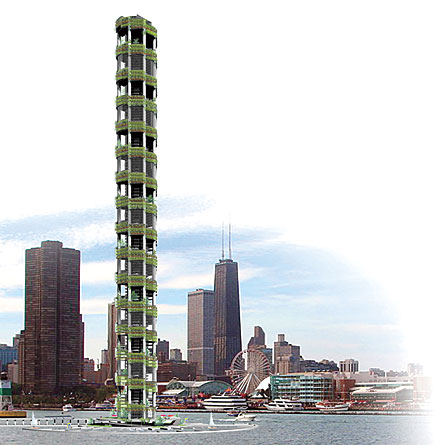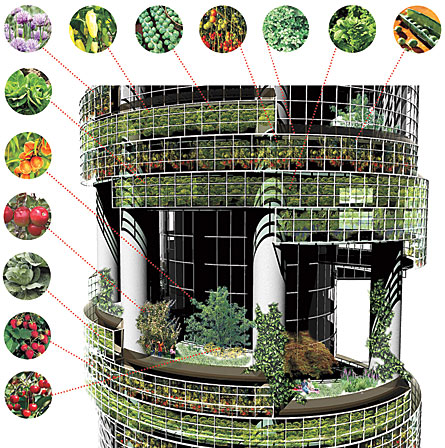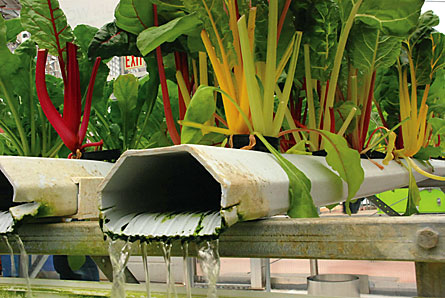- More than 2 years ago
Normal 0 false false false MicrosoftInternetExplorer4
Locally grown food is often touted as a perk of rural living. But if Dickson Despommier has anything to say about it, city dwellers will soon have the same environmental bragging rights.




Despommier wants cities to grow their own food. Not in rooftop gardens or neighborhood plots, but in light-filled buildings of glass and steel; tilapia on the first floor, tomatoes on the 12th.
It’s called vertical farming, baby, and it may be coming to a skyscraper near you.
The idea is bold, but Despommier makes a compelling case. Across a scattering of labs and disciplines, researchers are refining the technologies needed for the 21st century’s HangingGardens of Babylon. Energy efficiency and environmental impact are no longer concerns of the fringe. Increasingly, architects and city planners are looking to incorporate nature, rather than exclude it.
Some say the science for successful urban farming is already here. For years, NASA researchers have been exploring methods for growing plants on Mars, making midtown Manhattan seem not so far-fetched. Systems for growing plants without soil —hydroponics — are already in wide use. More recent are major developments in efficient artificial lighting and climate control technologies.
The benefits of urban farming range from meeting a concrete need to feed the Earth’s growing population to more nebulous perks, such as reducing wars fought over natural resources, advocates say. And the hurdles are like those that impede large-scale change wherever practices and policies are firmly entrenched — even if those practices and policies are inefficient and outdated.
Skeptics argue that the costs will always outweigh the benefits, so efforts should focus on improving efficiency in current production systems.
Vertical farming won’t get a free pass, says Gary Lawrence, a former planning director for the city of Seattle who is now with Arup, a London-based engineering and design firm. (Arup’s green projects include the “living roof” on the new California Academy of Sciences building in San Francisco and Dongtan, the eco-city planned for an island off Shanghai, China.) “There’s a huge amount of research going on, but we need to get the costs down,” he says.
Reducing carbon dioxide emissions from food transport, using biofuels or generating methane from compost have to make good business sense, Lawrence says. Ultimately, “the choice to act is a policy and financial issue.”
Purely as a numbers game, vertical farming makes sense, says Despommier, who makes his academic home in the environmental health sciences department at ColumbiaUniversity.
By his calculations, it currently takes a chunk of land the size of the state of Virginia to feed New York City. A 2007 United Nations report estimates that there will be nearly 5 billion urban dwellers worldwide by the year 2030, compared with 3.2 billion today. Where will their food graze and grow?
“We need to find new ways to grow food,” says Benjamin Linsley, spokesman for New York Sun Works, a sustainable-engineering firm. “If you can stick farming anywhere you like — and say ‘we don’t need soil’— then a huge door opens.”
There is more to vertical agriculture than addressing the land-to-mouth ratio, say proponents. Growing food in the asphalt jungle could help return stability to an easily perturbed agriculture sector, one where increased demand for a single crop, such as corn, is felt from movie theaters to hog farms. And urban farming enhances a city’s ability to deal with hazards and disasters, Lawrence says.
“In the developed world our entire system of getting food to people has to do with just-in-time delivery,” he says. “Our trucking systems have to work; our trains have to work. No one has inventory anymore. We saw the most tragic example of this in New Orleans with Katrina. As a community becomes isolated, how do they feed themselves?”
Despommier envisions buildings where water is recycled throughout, nonedible plant parts are composted and methane is collected and turned into heat. Water from pools holding freshwater fish, such as trout and striped bass, is filtered and routed to peppers and strawberries, which are pollinated by resident bees. Chickens cluck on one floor while pigs snuffle about on another — their waste turned into pellets that become an energy source.
The idea appears immensely practical from a food production
point of view, but Despommier doesn’t stop there. Vertical agriculture offers
the promise of urban renewal, he says. Abandoned properties become vibrant
neighborhood centers. The first floor of each building might host a farmers
market, providing jobs along with fresh, healthy produce.
Ecobenefits
Then there are the ecological benefits of subverting the dominant agricultural paradigm. A parasitologist by training, Despommier points out that turning forest into farmland can unleash infectious diseases and enhance their spread. Traditional farming has left waterways polluted with fertilizer and pesticides. Recent analyses find that topsoil is eroding 10 times faster than the natural replenishment rate in the United States, and in China and India it is 30 to 40 times faster than the natural rate.
Vertical farms would soften the blow of traditional farming, says Despommier, giving injured land the chance to heal.
“I want to put trees back on the land. I want to be the Lorax,” he says, referring to the mustached Dr. Seuss character who “speaks for the trees.”
Despommier’s vision and enthusiasm hint at the quixotic. Taped to the edge of his desk is a yellowing fortune from a cookie eaten long ago: “Nothing is impossible to a winning heart.” The vertical farm project’s website (www.verticalfarm.com) asks, “Don’t our harvestable plants deserve the same level of comfort and protection that we now enjoy?”
In a year of near-record flooding in parts of the Midwest and Northeast, the question seems less tongue-in-cheek.
“What happens outside is lightning bolts strike; there are floods, pests, drought,” says Despommier. “You can control everything indoors. You can’t control anything outdoors.”
Plant growth in indoor environments can now be controlled with unprecedented precision, as can the environments themselves, says Gene Giacomelli, director of the ControlledEnvironmentAgricultureCenter at the University of Arizona in Tucson. The center’s current research projects include refining a technique that limits water to the precise amount needed for growth. In this setup, known as deep flow hydroponics, the plants float on a body of water, completely covering the surface. With the right software and an Internet connection, scientists can monitor the pH, amount of nutrients, dissolved oxygen, air temperature, humidity, light intensity and CO2 from a distance.
But as a scientist involved with developing greenhouses for the South Pole, the moon and Mars, Giacomelli is familiar with the difficulties of growing things where they don’t usually grow.
“If I was going to play devil’s advocate, I’d say it is going to be tough,” he says. “You’re forcing a building, which typically wants to be low humidity — to have dust rather than mildew —to be something that needs high humidity. At the end of the day it is going to be raining in these buildings.”
Climate control is an issue for both the structure and its inhabitants. Plants can be finicky creatures. Some, such as lettuce, prefer cool weather, while melons and tomatoes like it warm.
Lighting is another factor. The majority of edible crops are what gardeners call “full sun” plants. Evenly distributing light across all plants — so all can go about their photosynthesizing business without burning or shivering — is no small task, Giacomelli says. Renderings of vertical farms often incorporate artificial light, preferably cast by light-emitting diodes, or LEDs. These are enormously more efficient than incandescent bulbs, which exude about two-thirds of their energy as heat, not light.
Scientists at NASA and elsewhere are fine-tuning LEDs to emit light in the wavelengths best for plants, which research suggests is mostly red and blue light. (Scientists at the KennedySpaceCenter found that with no green light, their lettuce looked purplish-gray, making monitoring plant health difficult. Adding 24 percent green light enhanced growth and improved aesthetics.)
“LEDs are coming on strong — they work very well from a biological standpoint,” Giacomelli says. “But for now, they just aren’t as cost effective as a high-pressure sodium lamp.”
Giacomelli sees light distribution, climate control and the integration of cooling and heating systems as vertical agriculture’s primary challenges. He doesn’t doubt it can be done — the greenhouses at the South Pole produce enough veggies that the core group of 50 to 70 people can have a fresh salad at least once a day, every day of the year. But any farming in a controlled environment requires a serious mechanical thumb in addition to a green one, he says.
It isn’t clear whether vertical farming will ever be realized, but the idea does have legs. In May, at the World Science Festival in New York City, Despommier presented the vertical farm project to an audience peppered with Nobel laureates. He has been contacted by an MIT professor who wants to include vertical farm designing in his capstone course.
Financial obstacles
Even if the idea takes off, actual construction of a vertical farm is probably years away — estimates range from five to 15, at least. A building-sized stumbling block is cost.
One financial issue to contend with is competition with more lucrative structures, says New York Sun Works’ Linsley. “With urban farming the biggest challenge is finding land,” he says. The low yield and profits from a single-story, ground-level greenhouse can’t compete with the profits offered by development. The condo always wins.
And single-story — or single-rooftop — gardens can’t feed the masses. This realization was the seed that bloomed into vertical farming, says Despommier. In his ecology course at Columbia, students were tasked with calculating the amount of food they could grow if all of Manhattan’s residential rooftops were gardens. The math said these roofs could provide a paltry 2 percent of the caloric needs of New York City.
There are many benefits to outfitting buildings with living roofs, Despommier says. “But the fact is, rooftop gardening is a trivial activity when you look at food production.”
Their naïve enthusiasm crushed, his students became surly but then bounced back with vigor. Not only does New York have plenty of rooftops, it has plenty of abandoned buildings — why not farm from basement to penthouse?
The cost — in both dollars and emissions — of retrofitting old buildings, or building new ones from scratch, is so great that it is hard to imagine getting any environmental bang for the buck, says Christopher Weber of Carnegie Mellon University in Pittsburgh. Weber, who investigates environmental impacts of food production and consumption, says the assumptions that vertical agriculture proponents begin with are faulty.
“We are not running out of land. We could easily grow twice as much food as we are currently growing,” he says. And that’s under today’s inefficient regime. As changes happen in the current system — shifting from grain-fed to grass-fed cattle, for example, or improving efficiency by tailoring crops to the local environment — there will be even more land available for food production.
For those who can’t wait for the urban farms of the future, rooftop gardens that use existing technologies can provide healthy produce and put urban dwellers in touch with food roots, Linsley says. The Science Barge, a brainchild of New York Sun Works and its sister company BrightFarm, offers a rooftop garden prototype, a public demonstration of urban farming that comes close to being carbon neutral. Two greenhouses sit atop an old barge, which for much of this summer was parked on the Hudson off the
68th Street pier. Roughly 80 percent of the barge’s energy comes from two solar panels that track the sun. An array of tiny windmills and a biodiesel generator fill in the gaps.Within the greenhouses are stacked towers of strawberry plants, rows of leafy greens such as chard and basil, and climbing peppers, melons and tomato plants. The plants are grown hydroponically; the essential nutrients are added to collected rain and river water, which is circulated among the plants with a series of tubes and gutterlike containers. Every month or so, when algae begin to gunk up the pipes, the crew cleans out the tanks and gutters. A bed of nonedible marsh grasses at the opposite end of the barge drinks the old water, closing the loop.
More than just an education center for local schools, the barge is a research center for urban agriculture. Sun Works is already using data from the barge in rooftop garden designs for three Manhattan schools. In addition to capturing storm water and preventing heat loss from the buildings, the gardens will provide fresh veggies for the lunchroom.
“We don’t just want to prove to people that it works,” Linsley says. As important as the proof of principle is the data gathering. A sophisticated array of sensors and machines records the patterns of energy use, which can be extrapolated out to larger projects and systems.
“A lot of people in the foodie world are wedded to organic techniques,” Linsley says. “But they very quickly realize that we can’t feed the world with organic techniques.” Rural farming isn’t going to disappear, he says, and crops such as apples and corn might never make sense in a greenhouse. Grow those crops organically where you can, and complement these organic farms with high-yield greenhouse production that is done sustainably, he says.
Along with all that environmentally friendly stuff, one of the most persuasive arguments for growing food in cities is obvious to anyone who has eaten a tomato that has been picked too soon and grown to survive a week in a refrigerated truck.
“People are very aware that food doesn’t taste as good as it should,” Linsley says. The produce grown on the Science Barge is a testament to what city-grown produce could and should be. “Our tomatoes are radically different.”






